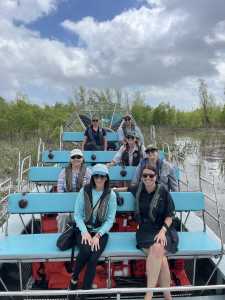Disclosure :: This post is sponsored by Restore the Mississippi River Delta.
The Mighty Mississippi, Diversion, and Why You Should Care
It comes as no surprise to any Louisianian that our state has lost miles of land that have disappeared into open water. Natural disasters like hurricanes (like Katrina, Rita and Ida) contributed to this loss along with the BP oil spill. Ida, in particular, caused a LOT of land loss. Over 100 sq miles very close to New Orleans were lost. If not for a healthy Davis Pond, it is assumed that Ida actually could have been a lot worse for communities like St. Charles Parish.
As the delta disappears, so does the protection it provides. Restore the Mississippi River Delta is working to counteract this problem, and we were recently given a firsthand view of the Davis Pond diversion’s success in St. Charles Parish. Projects like Davis Pond are protecting the protection systems in place. This peek into our coastal restoration was truly fascinating!

What is a Freshwater Diversion?
Located just 15 miles upstream from New Orleans, the Davis Pond freshwater diversion was established to balance salinity levels in nearby waterways. It has also built new land in the diversion’s outfall area. This area is now flourishing with wildlife and vegetation, which we observed on our tour. We saw, firsthand, why we need diversions to allow the river to continue to build land and sustain habitats in Louisiana.
So what does all this mean exactly? According to Restore the Mississippi River Delta, freshwater diversions restore the historic processes that once helped sustain wetlands by
channeling fresh water from the river into nearby basins. This project helps maintain and increase the health of existing wetlands over the long term by reducing salwater intrusion, preventing the loss of highly productive freshwater marshes and swamps in the upper ends of the estuary. Freshwater diversions work with restoration projects to maintain optimal salinities and lengthen the lifespan of marsh creation projects.
Do Freshwater Diversions and Restoration Work?
Completed in 2002, we can see in just 10 years the progress made for Louisiana’s eroding coastline. We need this for future generations, creating a thriving habitat for wildlife and increasing commercial and recreational fish productivity. Approximately 33,000 acres of wetlands will be preserved and 777,000 acres of marshes and bays will benefit during the 50-year life span of this project.
Continuous marsh loss surrounding New Orleans is caused by gradual sinking of land, erosion and saltwater intrusion. When they introduce freshwater, nutrients and sediment from the Mississippi through the Davis Pond Diversion, it can reduce these causes in the Barataria Basin.
How Do We Move Forward and Help Protect our Wetlands?
So what can we, as citizens, do about it? Stay informed and get involved. We need to educate our children, speak about the benefits of diversions and work to protect our wetlands for the future. Sign up to learn more at https://mississippiriverdelta.org/ and follow them on Instagram.
SIGN UP TO LEARN MORE!
Restore the Mississippi River Delta is a coalition of Environmental Defense Fund, National Audubon Society, the National Wildlife Federation, Coalition to Restore Coastal Louisiana, and Pontchartrain Conservancy. Together, they are working to rebuild coastal Louisiana’s nationally-significant landscape to protect people, wildlife and jobs.

















